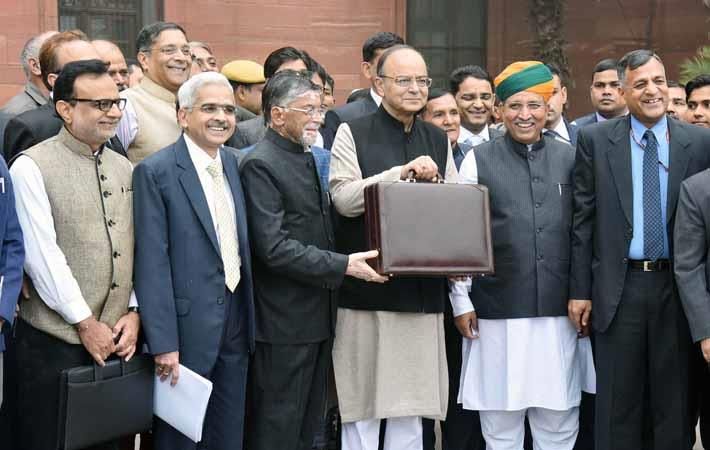Budget looks at MSMEs, Economic Survey expects new jobs

About 96 per cent of Micro Small and Medium Enterprises (MSMEs) in the country are likely to benefit from the 25 per cent cut in corporate tax rate for MSMEs having revenues less than Rs 50 crore. Among others, this cut is likely to affect the textiles and apparel industry considerably, since the backbone of this industry is made up MSMEs. This was also the segment reported to have been the worst-hit sectors of the economy due to the November 2016 demonetisation.
The announcement was made by finance minister Arun Jaitley in his speech while presenting the Union Budget 2017-18 in Parliament on Wednesday.
The minister said, "In order to make MSME companies more viable and also to encourage firms to migrate to company format, I propose to reduce the income tax for smaller companies with annual turnover up to Rs 50 crore to 25 per cent. As per data of Assessment Year 2015-16, there are 6.94 lakh companies filing returns of which 6.67 lakh companies fall in this category and, therefore, percentage-wise 96 per cent of companies will get this benefit of lower taxation. This will make our MSME sector more competitive as compared to large companies. The revenue forgone estimate for this measure is expected to be Rs 7,200 crore per annum." For MSMEs with turnover up to Rs 2 crore, the presumptive tax will be lowered from 8 per cent to 6 per cent. The profit deduction period for entrepreneurs has also been increased from the previous three out of five years. Startups can now claim 100 per cent deduction of profits for three out of the first seven years.
The roll-out of the goods and services tax (GST) is also expected to happen soon. Jaitley said in his speech, "It is my privilege to inform this august house that the GST Council has finalised its recommendations on almost all the issues based on consensus and after spirited debate and discussions. The preparation of IT system for GST is also on schedule. The extensive reach-out efforts to trade and industry for GST will start from 1st April, 2017 to make them aware of the new taxation system." He, however did not mention when the GST would come into force.
The government has also decided to streamline foreign direct investment (FDI), and will be disbanding the Foreign Investment Promotion Board (FIPB). The minister announced, "More than 90% of the total FDI inflows are now through the automatic route. The FIPB has successfully implemented e-filing and online processing of FDI applications. We have now reached a stage where FIPB can be phased out. We have therefore decided to abolish the FIPB in 2017-18. A roadmap for the same will be announced in the next few months. In the meantime, further liberalisation of FDI policy is under consideration and necessary announcements will be made in due course."
Like last year, this Budget too did not have anything specific for the textiles and apparel industry. However, the Economic Survey 2016-17 that was presented on Tuesday was more insightful for industry. In the section on trade policy, the Survey had noted, "On the need to promote labour-intensive exports, India could more proactively seek to negotiate free trade agreements with the United Kingdom (UL) and Europe. The potential gains for export and employment growth are substantial. Based on work initiated in last year’s Survey, we calculate additional $3 billion in the apparel and leather and footwear sectors and additional employment of 1.5 lakh."
This employment-generation potential has been elaborated in a chapter titled 'Clothes and Shoes: Can India Reclaim Low Skill Manufacturing?' It said India has an opportunity to promote the apparel, leather and footwear sectors because of rising wage levels in China that has resulted in that country stabilising or losing market share in these products. The Survey had called this a historic opportunity, and pointed out that the space vacated by China was being filled by other countries and not India. It also admitted that the textiles package of June 2016 do not address all the challenges faced by the industry.
Moreover, the Survey had called for the need to act, and act fast. It remarked, "India is well positioned to take advantage of China’s deteriorating competitiveness because wage costs in most Indian states are significantly lower than in China. Alas, this is not happening, or at least, not enough. The space vacated by China is fast being taken over by Bangladesh and Vietnam in case of apparels; Vietnam and Indonesia in case of leather and footwear. Indian apparel and leather firms are relocating to Bangladesh, Vietnam, Myanmar, and even Ethiopia. The window of opportunity is narrowing and India needs to act fast if it is to regain competitiveness and market share in these sectors. Hence, the urgency."
Among other things, the Survey called for India to carefully weigh the costs and benefits of negotiating new free trade agreements (FTAs) with the Eurpoean Union (EU) and the United Kingdom (UK). It noted, "Based on recent in-house analysis in 2016, it is estimated that an FTA with the EU and UK can lead to 108029, 23156, and 14347 additional direct jobs per annum in the apparel, leather and footwear sectors respectively. Many more indirect jobs could be added, although these are more difficult to estimate."
The Survey concluded, "More FTAs, GST-induced tax rationalisation, and labour law reform would add considerably to the job creation potential of the clothing and footwear sectors. All industrial policy aimed at promoting particular sectors is not without risks. But the externality generating attributes-employment, exports, social transformation – of the apparel and footwear sectors, India’s potential comparative advantage in it, and the narrow window of opportunity available, make the risk worth taking. And, in any case, many of the proposed policy responses such as FTAs, tax rationalisation, and labour law reform could have wider, economy-wide benefits."
All this seems to be in sync with the June 2016 textiles package which had sought to emphasise on job creation. In fact, last year’s economic survey had remarked, “India’s apparel sector is dominated by the informal sector, with approximately 2 million establishments employing about 3.3 million workers (average size 1.5 workers), dwarfing the formal apparel sector’s 2800 firms which employ 330,000 workers (average size 118 workers). Indeed, apparel firms now make up the largest share of establishments in the informal sector.” The labour productivity of formal sector apparel firms is about Rs430,000 per worker compared to the informal apparel sector’s Rs28,800 per worker.
The 2015-16 Survey had said, “We highlight a business model that some formal sector apparel manufacturers are adopting—relocating in second- and third-tier towns and cities. This business model of moving factories to workers has a number of commercial and social advantages—it involves spreading economic development to underdeveloped areas, reduces spatial mismatch in the labour market and can improve competitiveness by raising firms’ access to lower cost labour.”
Fibre2Fashion News Desk – India
































-Ltd..jpg?tr=w-120,h-60,c-at_max,cm-pad_resize,bg-ffffff)





.jpg?tr=w-120,h-60,c-at_max,cm-pad_resize,bg-ffffff)
.jpg?tr=w-120,h-60,c-at_max,cm-pad_resize,bg-ffffff)






